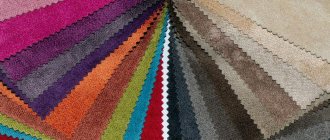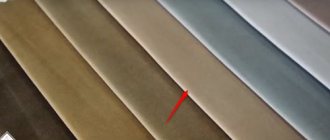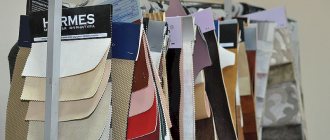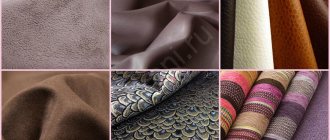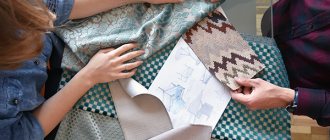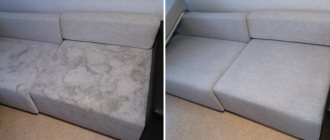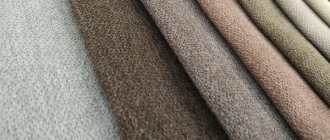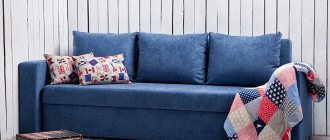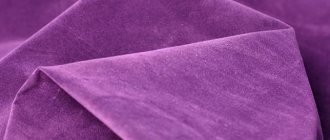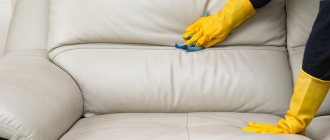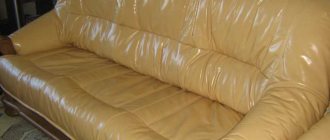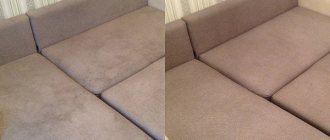Upholstery for a sofa can either reduce the cost or make the sofa several times more expensive. How to choose the most optimal price and quality fabric for upholstering a sofa? After all, we may encounter this as when purchasing sofa to order, and when reupholstering old furniture. And you must admit, I really want to make the right choice and be happy with the purchase!
Furniture upholstery fabric has 8 categories. The higher the category, the higher quality the fabric, and therefore more expensive.
- Category 0 – light fabrics (cotton, scotchgard, series of fabrics with fluffy thread and inexpensive thermal jacquard);
- Category 1 – inexpensive fabrics (flock, corduroy, simple chenille and tapestry, faux suede);
- Category 2 – denser and more practical, including everything listed in category 1, as well as transitional materials with related properties;
- Category 3 – denser fabrics (chenille, faux suede and nubuck, tapestry and fabrics with complex textures);
- Category 4 – heavy furniture fabrics of the listed names and faux fur;
- Category 5 – natural fabrics based on natural fibers;
- Category 6 – expensive leatherettes and luxury fabrics;
- Category 7 – genuine leather and luxury fabrics;
- Category 8 – expensive genuine leather and rare fur.
Before choosing upholstery for your sofa, do not overlook some features:
- Are there any pets in the house?
- Are there children in the house?
- What room do you choose a sofa for?
Categories
All types of fabrics intended for upholstery must meet certain requirements:
- high attractiveness, compliance with a certain style and tastes of furniture owners;
- upholstery fabric must be resistant to abrasion and shrinkage, as well as stretching;
- resistance to fire, high temperatures and moisture;
- environmental friendliness, since all upholstery materials must be safe for permanent use in residential premises;
- resistance to fading if the furniture structure will be installed in an area of the room where it will constantly be exposed to sunlight;
- the presence of a high-quality and durable base.
When choosing upholstery fabric, you should decide on its category.
There are several categories of fabrics that are used to form coatings on different interior items. The category is determined depending on various material parameters. Its strength, operational parameters, appearance, weight and cost are taken into account.
In accordance with this, furniture fabric can be presented in the following categories:
- Category 1 – servant, shennyl, scotchguard;
- 2 and 3 categories - cotton of significant density, flock, corduroy, suede;
- Category 4 – tapestry, jacquard;
- 5, 6 categories – artificial leather, arpatek;
- Category 7 – genuine leather of low density and cost;
- Category 8 – genuine leather of significant density and price.
Thus, upholstery material is produced in numerous types, differing in category and other parameters. Before purchasing any variety, it is recommended to evaluate all its features to ensure the advisability of such a purchase.
Requirements
Furniture fabrics are special upholstery materials that are mounted on top of sofas, armchairs and other interior items. Their quality must meet strict standards and high performance characteristics.
There are a number of increased requirements for upholstery fabric:
- durability quality;
- creative design solution (color scheme, print, style);
- comfort.
The durability of the material lies in the presence of the following properties:
- strength and wear resistance;
- color fastness, resistance to fading;
- resistance to chemically active substances;
- dirt and water repellency;
- abrasion resistance;
- environmental cleanliness;
- tendency to pilling;
- the ability to maintain its presentation for a long time.
Attention . Upholstery fabrics offered by suppliers are examined according to special indicators, and only after that they are included in the working collections of furniture manufacturers.
Kinds
Various materials can be used to cover upholstered furniture. They have their own parameters and properties. It is advisable to study all types in advance, as well as view photos of furniture with each type in order to make the right choice.
Velours
Velor is considered a rather interesting choice for creating high-quality furniture upholstery. Its main features include:
- velor is velvety to the touch, so it is incredibly pleasant to touch;
- the pile on such a coating can always be located in a vertical state, or in certain areas of the coating it can be laid on one side;
- velor can be made using different bases, for which cotton or wool is used, with a wool base being used most often;
- It is easy to care for the velor coating, as it is created using high-tech fibers;
- this upholstery fabric for furniture has antistatic parameters;
- is a hypoallergenic material;
- contaminants are easily removed from the surface.
However, velor has some disadvantages. This includes the high cost of the material. Additionally, velor does not have good resistance to various mechanical influences.
Scotchgard
This modern material has the same positive parameters as jacquard, but at the same time has a low price. Its advantages include:
- long service life;
- resistance to various stains;
- environmental cleanliness due to the use of only natural ingredients;
- the softness of the resulting upholstery;
- high coating strength.
Various stains can be easily removed from this material for upholstery of upholstered furniture, for which a standard soap solution is suitable. It is not allowed to use abrasives, wash the fabric at high temperatures or let it dry.
Jacquard
Jacquard is used quite often for furniture upholstery. This material has an original ornament, and there is certainly a large report. When choosing jacquard fabrics, it is determined whether their composition will be plain or mixed.
Jacquard is an expensive material, so when choosing it, you should prepare for significant expenses.
The advantages of this material include high strength and long service life. It is available in numerous colors, but has a high cost. If you choose a material with an anti-claw effect, it will be expensive.
Thermo-Jacquard
This material appeared relatively recently. Choose the optimal fabric for each soft interior item. Coloring is done using thermal printing technology. A special feature of this material is the presence of unusual and unique colors, and the bright colors last a long time. Additionally, the fabric is highly wear-resistant and durable.
Chenille
Chenille is chosen quite often for various upholstered furniture. The material got its name due to the fact that the composition includes a special thread, similar to a caterpillar with a high pile.
The positive parameters of using this material include:
- it is possible to choose fabric with an anti-claw effect, which is important for every pet owner;
- the material has good density;
- considered a durable fabric;
- dust can be easily removed with a conventional vacuum cleaner with appropriate attachments;
- the price is acceptable for every buyer.
Chenille is produced on an adhesive or fabric basis. The disadvantages of the material include its low cost before exposure to moisture, as well as the drying time after cleaning.
Flock
Flock is a popular finishing material. It is made using cotton and polyester. A pile is applied to the surface of the base using the electrostatic method. Flocking is considered a popular procedure that allows you to obtain high-quality material, which is chosen quite often among decorative products.
Flock has the following advantages:
- good strength;
- ease of care;
- resistance to exposure to sunlight, moisture or dirt;
- has an attractive appearance.
Flock is an environmentally friendly material. It is highly dense and holds its shape well. Therefore, when answering the question of which fabric is best for upholstery, the choice often falls on flock.
Microfiber
The material does not fade, does not fade with constant exposure to ultraviolet radiation and has good resistance to moisture. May have a special anti-claw effect. Before choosing microfiber for upholstery, please note that the material should not be exposed to high humidity or temperature.
The main disadvantage is the high cost. For a long service life of such upholstery, you will need to put a lot of effort into specific care. To do this you will have to purchase special care products.
Faux leather
The most popular types of upholstered furniture are made of natural or artificial leather. If you purchase such upholstery for rooms where pets live, then there must certainly be anti-claw protection. It is so called because it provides effective protection of the material from animal claws.
High-quality artificial leather has parameters similar to natural material, but has an acceptable cost. Provides truly attractive, luxurious and unusual upholstery.
Genuine Leather
The use of such material will require significant financial investments. Its advantages include high attractiveness, ease of maintenance, and it fits perfectly into different interior styles.
The cost of the material is considered high, and if animals live in the house, then anti-claw protection must be used, otherwise the upholstery will quickly lose its attractiveness due to the impact of pets’ claws.
Velveteen
The advantages of this material include:
- high resistance to wear;
- environmental cleanliness;
- good elasticity;
- high strength;
- ease of care;
- acceptable cost.
The disadvantages include fading in the sun and shrinkage after washing. Various mechanical influences contribute to the loss of attractiveness of the fabric.
Arpatek and faux suede
Previously used to form armchair upholstery. It is a type of artificial leather. Its advantages include resistance to ultraviolet radiation and abrasion. It is tear resistant. Its cost is considered quite high, but it is due to its positive parameters.
The use of artificial suede for furniture upholstery is considered quite popular. The material is pleasant and has an unusual texture. Each piece of furniture with such upholstery, which uses artificial suede for furniture upholstery, looks elegant, unique and luxurious.
Tapestry
It is presented in a soft material with an organic weave of yarn, which creates an unusual pattern. The tapestry is available in numerous colors and textures.
Anti-vandal fabric is easy to wash, durable, pleasant and practical. Tapestry is a plastic material, so it can be used for various interior items. Its advantages include, first of all, its naturalness. The tapestry has an attractive appearance.
The disadvantages include not very good resistance to different loads. It is not allowed to clean the tapestry using wet methods, and it also has a high cost.
Velvet
Velvet is a unique fabric with fluffy pile, but it should be short. If the pile is long, then the material is called velor. Velvet is usually chosen for interior items with specific shapes.
Velvet fabric can have different patterns and is also available in a single color.
Velvet makes any sofa or armchair elegant, luxurious and fits perfectly into different classic interior styles. The most commonly chosen materials are black or blue velvet. These colors help create a unique atmosphere in any room.
Proper care
To prolong the life of upholstery fabric, you should adhere to proper care in accordance with the requirements:
- The higher quality the fabric, the more delicate it is to care for.
- For materials that require dry cleaning using organic solvents or mechanical friction, wet cleaning should not be used, otherwise it will damage the fabric.
- Contamination should be removed as quickly as possible.
- There is no need to apply excessive force and rub the fabric so as not to disturb the structure of the material, stretch the threads or get bald spots in the pile upholstery.
- It is recommended to wash removable furniture covers without mixing them with other textiles, following the care instructions.
- It is not advisable to mix cleaning products intended for different types of fabrics.
- You need to wash stains with a sponge or brush with a product applied to it.
- If the contamination is severe and cannot be cleaned at home, you can use the services of professional dry cleaning.
It becomes clear that choosing upholstery fabric is an important and responsible matter. Velor is pleasant to the touch, and tapestry is aristocratic, flock is modern, and matting is practical, each canvas is attractive in its own way. Having understood the features and properties of materials, you can create your own unique and inimitable style in interior design.
Tips for choosing
What is the best fabric to use for upholstery? It is possible to choose different types of materials, but certain criteria are taken into account:
- ease of cleansing;
- resistance to moisture, ultraviolet radiation, abrasion and other exposure factors;
- long service life;
- attractiveness;
- matching the color and texture to a specific interior style.
With the right choice of upholstery, it ensures an attractive and bright piece of furniture. It will fit well into the existing style and will also suit the tastes of the users.
Upholstery for a sofa in the living room
In the living room, the sofa is used more often than in other rooms, so the upholstery suffers the most from wear and tear. What should it be like? Durable and easy to clean. The following types of fabrics have these properties:
- Jacquard
- Microfiber
- Leather
Jacquard is a dense, durable and wear-resistant fabric with a beautiful soft texture, but is susceptible to moisture.
Microfiber - read information about the material above.
Leather is a noble, durable, elastic material. Very easy to care for.
What properties should such fabrics have?
According to GOST 24220-80, furniture fabrics must be tested for:
- paint fastness (on a scale from 1 to 8);
- fire resistance (when in contact with fire, the canvas should not immediately catch fire);
- proportion of fiber loss (loss of a large number of fibers under pressure is an indicator of low quality);
- abrasion.
Other important properties include:
- density;
- water- and dirt-repellent properties;
- beautiful colors;
- use of environmentally friendly fibers in production;
- resistance to exposure to the sun and toxic chemical compounds.
Pros and cons of furniture fabrics
Pros:
- Jute, cotton and linen are environmentally friendly and breathable.
- Acrylic, nylon and nylon are reliable and durable.
- Viscose, velor, matting and artificial suede allow air to pass through well.
- Upholstery made of genuine leather looks expensive and solid.
Minuses:
- Linen, jute, cotton and viscose wear out quickly.
- Synthetic upholstery is more toxic than natural upholstery and is less breathable.
- Natural materials are expensive.
- In most cases, the furniture will be left with marks from the teeth and claws of animals.
- Velor and artificial suede absorb unpleasant odors.
